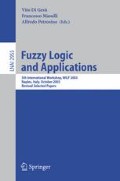Abstract
In this paper, we propose a modeling paradigm that uses fuzzy sets to represent concepts on which control modules of a behavior-based autonomous robot operate. The primitives defined in the modeling paradigm are expressive enough to represent the knowledge needed by planning, coordination, and reactive control of a multi-robot control system. At the same time, it provides a well-founded tool to represent in a compact way the data interpretations, needed to reason effectively about what is happening in the world and what is desired to happen. This modeling paradigm makes the design of behavior, planning, and coordination modules easy, since its primitives are simple and expressive.
Access this chapter
Tax calculation will be finalised at checkout
Purchases are for personal use only
Preview
Unable to display preview. Download preview PDF.
References
Arkin, R.C.: Behavior-Based Robotics. MIT Press, Cambridge (1998)
Asada, M., Kitano, H., Noda, I., Veloso, M.: Robocup: today and tomorrow – what we have learned. Artificial Intelligence Journal 110, 193–214 (1999)
Bonarini, A., Invernizzi, G., Labella, T., Matteucci, M.: An architecture to co-ordinate fuzzy behaviors to control an autonomous robot. Fuzzy Sets and Systems 134(1), 101–115 (2002)
Bonarini, A., Matteucci, M., Restelli, M.: Anchoring: do we need new solutions to an old problem or do we have old solutions for a new problem? In: Proceedings of the AAAI Fall Symposium on Anchoring Symbols to Sensor Data in Single and Multiple Robot Systems. AAAI Press, Menlo Park (2001)
Bonarini, A., Restelli, M.: An architecture to implement agents co-operating in dynamic environments. In: Proc. of AAMAS 2002 - Autonomous Agents and Multi-Agent Systems, pp. 1143–1144. ACM Press, New York (2002)
Author information
Authors and Affiliations
Editor information
Editors and Affiliations
Rights and permissions
Copyright information
© 2006 Springer-Verlag Berlin Heidelberg
About this paper
Cite this paper
Bonarini, A., Matteucci, M., Restelli, M. (2006). Concepts and Fuzzy Models for Behavior-Based Robotics. In: Di Gesú, V., Masulli, F., Petrosino, A. (eds) Fuzzy Logic and Applications. WILF 2003. Lecture Notes in Computer Science(), vol 2955. Springer, Berlin, Heidelberg. https://doi.org/10.1007/10983652_10
Download citation
DOI: https://doi.org/10.1007/10983652_10
Publisher Name: Springer, Berlin, Heidelberg
Print ISBN: 978-3-540-31019-8
Online ISBN: 978-3-540-32683-0
eBook Packages: Computer ScienceComputer Science (R0)

